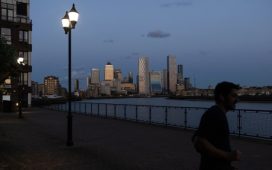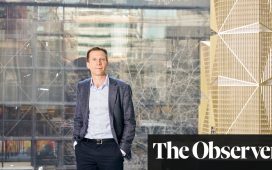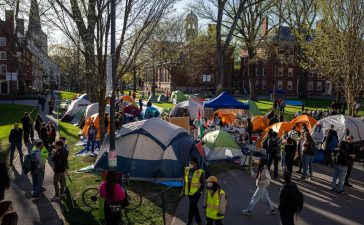Scott Rechler ploughed billions of dollars into Manhattan office properties after the 2008 financial crisis, amassing one of the city’s biggest portfolios through a flurry of deals. Now Rechler, the chief executive of property developer RXR, is preparing to surrender some of his offices to lenders.
The decision comes after an exhaustive review of RXR’s properties and is an acknowledgment that some that generated steady, if unspectacular, returns no longer make economic sense in a new era of remote work and rising interest rates.
“With some of those, I don’t think there’s anything we can do with them,” Rechler said. The only alternative, he explained, was to “give the keys back to the bank” — developer-speak for halting debt payments and relinquishing control of the asset while trying to work out a solution with the lender. “Give the keys back to the bank. And you’ve got to be disciplined about it.”
Nearly three years after the Covid pandemic shut down New York City and fundamentally changed the way people work, RXR’s plans reflect a growing consensus that the world’s largest office market is heading for a calamitous period. Dated buildings in humdrum locations will spiral into obsolescence unless they can be repurposed for other uses. Meanwhile, developers are betting that the best and most advanced towers — laden with technology and amenities and situated by mass transit — will prosper.
The best example of the latter may be SL Green’s One Vanderbilt, which soars over Grand Central Station and has fetched record rents, even in the midst of the pandemic. Rechler is hoping that RXR’s forthcoming 175 Park, which will be the western hemisphere’s tallest building when it is completed, will eventually surpass it.

“We’ve had more showings for that building in the last, call it, 60 days, then we’ve had for the rest of our portfolio,” he said. Rechler also has high hopes for 5 Times Square, the former home of EY. RXR and its partners are spending about $300mn to revamp the building, adding everything from a new entrance hall and elevators to a spa.
Those bets may yet pay off. But Rechler, who is also a board member of the New York Federal Reserve, is expecting a rough stretch in the months ahead. The sharp rise in interest rates from historic lows is threatening all sorts of businesses that were predicated on cheap and readily-available capital, he noted. Even tech companies, one of the few remaining sources of office market expansion, are now jettisoning thousands of employees. Their cuts, in turn, appear to be rippling through Wall Street.
“When companies are laying off people, they don’t usually take more space,” Rechler said, adding: “The amount of development projects that we’re hearing about around the country that are stopping is mind-blowing.”
Rechler, 55, is the bullet-headed scion of a Long Island property fortune built by his grandfather, William, who developed a lightweight folding lawn chair after the second world war. William and his brothers poured the resulting profits into warehouses, industrial parks and suburban offices across Long Island.
It was a precocious Scott Rechler, still in his 20s, who convinced family members to take the business public in 1995, and then led a risky push into the Manhattan office market.
He has demonstrated a knack for timing. In January 2007, with the financial crisis looming, he sold the company, Reckson Associates Realty Corporation, to SL Green for $6.5bn.

Sixteen years later, he still shakes his head that some of his investors had to be convinced to support the deal. Rechler launched RXR and then waited until August 2009 to jump back into the market, spending $4.5bn over the next two years on office properties that were deeply discounted.
The first building he acquired had a 10-year lease to JPMorgan. While that now seems like a sure bet, it did not at the time, Rechler recalled: “We spent six weeks underwriting and thinking: what happens if JPMorgan goes out of business?”
New York’s office market recovered and, flush with foreign money, soon exceeded its previous highs. By 2016 the office market was peaking and RXR pivoted again. It switched its focus to apartments — so-called multifamily developments — in growing cities such as Denver and Phoenix, and industrial warehouses.
Both have been darlings of real estate investors in recent years. Even when their finances are strained, people will still pay rent, the thinking goes. Rents can also be raised in periods of inflation. Warehouses, meanwhile, have become vital nodes of ecommerce.
But with the pandemic, offices in New York and other cities are posing a desperate challenge for RXR and other developers. Rechler has accepted that “the genie is out of the bottle” and that hybrid work is not going away. “We’re a real estate company and we still let people work hybrid on Friday,” he said. “So, it’s here to stay.”
In December, he asked his team to draw up a set of metrics that took account of the new reality and then ranked RXR’s office holdings accordingly. “I call it Project Kodak,” Rechler said, referring to the once-dominant film company that was upended by new technology. “Some buildings are film, and some buildings are digital. The ones that are film, you’ve got to be realistic about it.”
RXR will not invest in those properties unless it can find a way to convert them to another use — or if it believes they can still prosper as low-rent alternatives. “But even there . . . I’d be concerned. Because they’re becoming competitively obsolete quickly. So milk what you can get out of it, figure out what to do and move on,” Rechler said. “The ones that are digital, that’s what you’ve got to focus on.”
He declined to say which, or how many, of his buildings were destined to go back to lenders — although he estimated about 10 per cent of RXR’s office portfolio fell into the “film” category.
Some of those may be candidates for converting to residential — an idea that has enthused both developers and New York mayor Eric Adams, whose city is chronically short of housing.
But, as Rechler observed, such projects are rife with complications. Even if a developer can solve architectural and zoning challenges, they first must empty the building of tenants. “It’s a long process. I’ve got to move tenants out, I’ve got to carry a vacant building — why go through that process? It’s not simple,” he explained, arguing that New York state would have to offer tax and regulatory incentives to make such projects feasible.
Still, Rechler does see opportunities in the office upheaval. Like other developers, RXR has created a property lending arm to step into the void left by banks after the 2008 crisis.
He expects to make about $2bn in high-yield loans this year for office and multifamily projects that have run short of cash as other lenders pulled back.
There should be opportunities. Many institutional investors are now desperate to reduce their office exposure. In some cases, Rechler argued, the projects were still viable but their debt ratios had suddenly ballooned because the underlying property valuations have been marked down.
“What you’re seeing is, a lot of institutions just don’t want to invest any more money into these buildings. So the sponsors are just sort of left in nowhere land,” he explained, adding: “This is going to be a tough time. [But] you can’t paint office buildings all with the same brush.”











